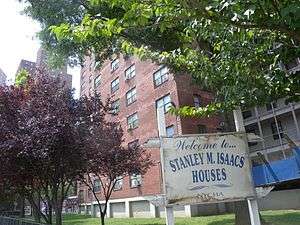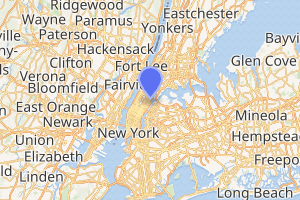Isaacs Houses
The Stanley M. Isaacs Houses (or Isaacs Houses) is a public housing project for those of low-to-moderate incomes located just south of 96th street in the Manhattan neighborhood of Yorkville. The Isaacs Houses and the Holmes Towers borders East Harlem, which has the second highest concentration of public housing in the New York City. The three public housing buildings in the Yorkville neighborhood of Manhattan in New York City, are 24 stories tall and contain 635 apartments. The project is located between 93rd and 95th Streets with playground & ball courts from 95th-97th street, stretching from 1st Avenue to the FDR Drive.[3]
Isaacs Houses | |
|---|---|
 | |

Location in New York City | |
| Coordinates: 40.781320°N 73.945510°W | |
| Country | United States |
| State | New York |
| City | New York City |
| Borough | Manhattan |
| Area | |
| • Total | 0.005 sq mi (0.01 km2) |
| Population | |
| • Total | 1,274 [2] |
| ZIP codes | 10128 |
| Area code(s) | 212, 332, 646, and 917 |
| Website | my |
Development
The Isaacs Houses were designed by architects Frederick G. Frost, Jr. & Associates and completed in 1965.[3] They were originally called the Gerald Swope Houses but renamed in 1963 the Isaacs Houses after Stanley M. Isaacs, who served as Manhattan Borough President under Mayor LaGuardia and later in City Council for 20 years as minority leader.[4][5][3] 45 percent of the apartments in Isaacs are set aside for tenants over the age of 62.[3]
The development has been designated a "high crime zone" by the New York City Police Department's 19th precinct since the early 2000s, and are thus policed to a higher extent, especially due to the heavy socio-economic mixing of the immediate surrounding area, which includes public housing, working-class small tenement buildings, middle-class medium-size buildings, and upper-middle class to upper-class luxury buildings along 1st avenue in the area.[6]
In 2018, the Isaacs Houses along with the Holmes Towers and Robbins Plaza, which are all run by the same managers, ranked the worst in the nation after federal inspections by the United States Department of Housing and Urban Development.[7]
References
- "St. Nicholas Houses Area". Retrieved November 7, 2019.
- "Isaacs Houses Population".
- "MyNYCHA Developments Portal". my.nycha.info. Retrieved July 2, 2019.
- Zipp, Samuel (May 24, 2010). Manhattan Projects: The Rise and Fall of Urban Renewal in Cold War New York. Oxford University Press. ISBN 9780199779536.
- "New City Housing to Bear Name of Stanley Isaacs". timesmachine.nytimes.com. Retrieved July 2, 2019.
- Crow, Kelly (November 10, 2002). "NEIGHBORHOOD REPORT: UPPER EAST SIDE; With Affluence All Around, A Little Crime Seems a Lot". The New York Times. ISSN 0362-4331. Retrieved February 7, 2019.
- Hicks, Nolan; Fenton, Reuven; Golding, Bruce (September 11, 2018). "Feds rank UES housing projects among worst in nation". New York Post. Retrieved July 2, 2019.